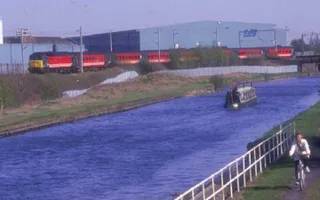Our waterways are transport routes. The towpaths are used for sustainable travel through walking and cycling. Increasing the use of our waterways by these means contributes towards reducing air pollution and carbon emissions. The water may also be used for commercial freight purposes.
Sustainable routes
We consider that waterways have an important role to play in delivering aspirations for sub-regional and local accessibility. They can provide safe and convenient cycle routes that connect people to jobs, key services and recreation opportunities. Enhancing the capacity, safety and attractiveness of towpaths and connecting pedestrian routes, particularly to and within city and town centres, may support increases in walking for local trips.
Commercial freight
Did you know? Carrying freight on our waterways, that would otherwise have travelled by lorry, generated a Mode Shift Benefit estimated to be about £260k in 2012-13.
There has however been a dramatic reduction in freight on our commercial waterways over recent years from 3.8million tonnes in 2001/02 to just 1.3m tonnes in 2011/12, and currently less than 0.5m tonnes p.a.
We have 10 commercial waterways i.e. those waterways that are principally available for the movement of freight by water. The movement of commercial vessels on the cruising network of broad and narrow canals – whether carrying freight or providing services to the boating community – are nevertheless welcome users, on the assumption that they operate within the current policies and arrangements for the operation and maintenance of the cruising network.
Our Freight Advisory Group have recommended a proposed strategy for waterborne freight. This reflects a view that there can be no ‘one size fits all’ approach to formulating policy for the 10 waterways, or even for all sections of the same waterway. The strategy promotes a Priority Freight Route approach. Priority Freight Routes being those waterways considered to have the highest potential for viable freight traffic.
Please contact us to discuss freight opportunities and take a look at our urban and rural freight case studies.
ExampleThe Aire & Calder Navigation from Goole Docks to Leeds has been identified as a priority freight route due to its connectivity and traffic potential with Humber Ports. The Leeds City Council Natural Resources and Waste Plan Policy 13 Minerals: Transport Modes safeguards three existing canal wharves. This is to protect them from development that would prejudice their long term availability for canal freight.




